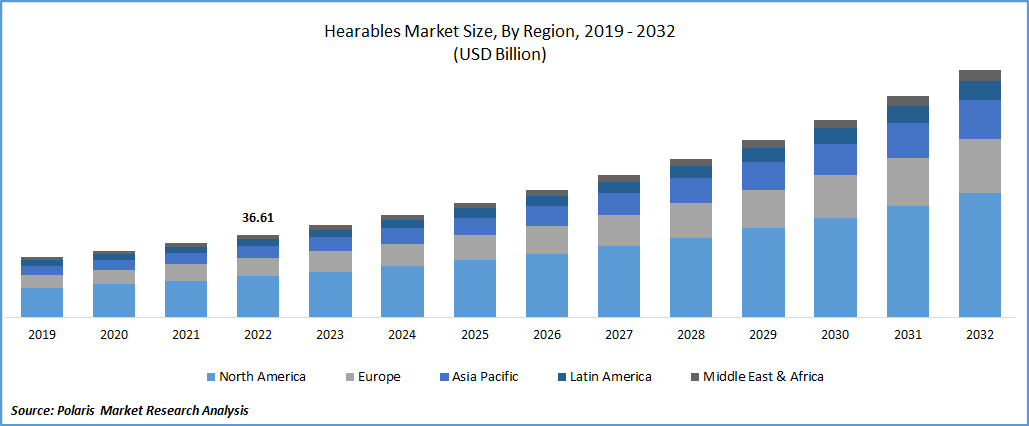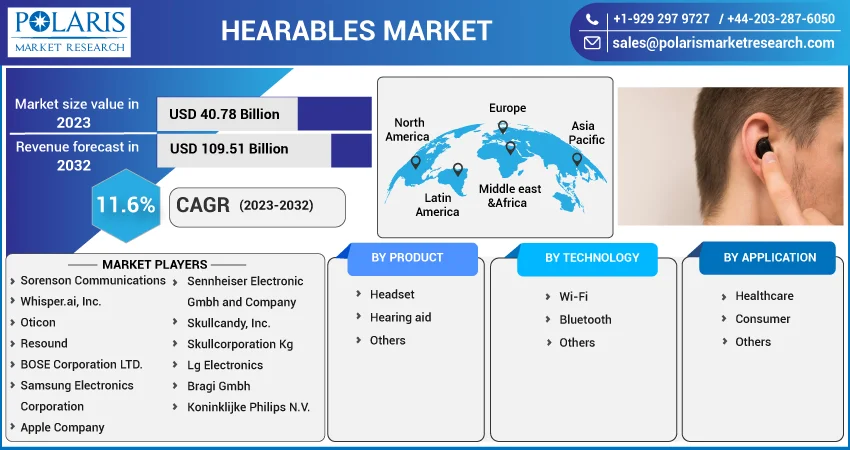
Hearables Market Share, Size, Trends, Industry Analysis Report
By Product; By Technology (Wi-Fi, Bluetooth, Others); By Application; By Geography; Segment Forecast, 2023 - 2032
- Published Date:Mar-2023
- Pages: 119
- Format: pdf
- Report ID: PM3043
- Base Year: 2022
- Historical Data: 2019-2021
Report Outlook
The global hearables market was valued at USD 36.61 billion in 2022 and is expected to grow at a CAGR of 11.6% during the forecast period. Hearables provide various functions, such as audio playback, communication, and fitness tracking. The hearables market has been growing rapidly in recent years, driven by technological advancements and increasing consumer demand for convenient and wearable technology.

Know more about this report: Request for sample pages
Hearables are increasingly integrating with AI and virtual assistants, such as Siri and Google Assistant, allowing for hands-free control and improved functionality. Many hearables now offer health and wellness features, such as heart rate monitoring, sleep tracking, and noise cancellation, which appeal to consumers looking for a more holistic approach to wellness. Hearables are being adopted by enterprise customers for use in industrial and workplace settings, offering improved employee communication and collaboration. Overall, the hearables market is expected to continue growing in the coming years, with new products and features being introduced to meet the demands of consumers and businesses.
The COVID-19 pandemic has had a significant impact on the hearables market. In the early stages of the pandemic, supply chain disruptions and factory shutdowns resulted in a production slowdown and a shortage of hearables products. However, the increased demand for wireless earbuds, headphones for remote work, and online learning helped to drive growth in the hearables market. Additionally, as people spent more time at home, there was a rise in demand for personal audio devices that offered comfort and improved sound quality. While the pandemic presented challenges for the hearables industry, it also introduced new opportunities for growth and innovation.

Know more about this report: Request for sample pages
Industry Dynamics
Growth Drivers
With the increasing popularity of wireless earbuds, the demand for hearables has skyrocketed. Consumers are drawn to the convenience and portability of wireless earbuds, which make them ideal for use in a variety of settings.
The advancements in technology have led to the development of hearables with improved sound quality, longer battery life, and more advanced features such as voice control and fitness tracking.
Hearables are increasingly being used for health and wellness purposes, such as monitoring heart rate, tracking physical activity, and measuring sleep patterns. This is driven by consumers' growing interest in health and fitness and their desire to improve their well-being.
Hearables are now integrated with smart devices such as smartphones, making it easier for users to access their music, make phone calls, and use various apps. As the hearables market continues to grow, there is increased awareness and acceptance of this new technology. This has led to increased marketing and advertising efforts, further driving growth in the hearables market.
Hearables, such as smart earbuds and hearing aids, have become increasingly popular in recent years, leading to a growth in the marketing and advertising of these devices. The increasing demand for hearables, combined with innovative marketing strategies, has resulted in significant revenue growth in the marketing sector of the hearable industry. Companies are investing heavily in marketing campaigns to promote their products and reach a wider audience, driving sales and revenue in the process. advancements in technology, growing consumer demand, and increasing awareness of the benefits of hearables. The growth of the hearable industry is also being driven by the increasing demand for wireless earbuds and other wearable devices, as well as the increasing adoption of voice-controlled virtual assistants.
Report Segmentation
The market is primarily segmented based on form, Product, Technology, Application, and Region.
|
By Product |
By Technology |
By Application |
By Region |
|
|
|
|
Know more about this report: Request for sample pages
The Headset segment is expected to witness the fastest growth
The headset segment is expected to dominate the market growth in the forecast period. The fastest growth is as both wired and wireless technologies continue to evolve and expand. However, in recent years, wireless technology has seen significant growth, driven by the increasing demand for mobile devices and the Internet of Things (IoT). The widespread adoption of 5G networks and the growth of smart homes and connected devices has fueled the growth of wireless technology.
On the other hand, wired technology continues to play a critical role in supporting high-speed internet and data transfer for businesses and data centers. Wireless technology is experiencing the fastest growth globally. The widespread adoption of smartphones, tablets, and other mobile devices has driven the demand for wireless networks and services. The development of new wireless technologies brings faster and more reliable experience for users. Additionally, the growth of the Internet of Things (IoT) and smart home devices has further increased the need for wireless technology.
The Hearing aid segment accounted for a significant market share in 2022
The hearing aid segment is considered for a significant market share within the broader hearing healthcare industry. Hearing aids have been growing in recent years due to a combination of factors, including an aging population, an increase in awareness of hearing loss and its impact on quality of life, and advances in technology.
The hearing aid segment offers a wide range of products, including traditional behind-the-ear (BTE) hearing aids, in-the-canal (ITC) hearing aids, in-the-ear (ITE) hearing aids, and completely-in-the-canal (CIC) hearing aids. The segment is also characterized by a high level of competition, with several major players offering a range of products and technologies to meet the needs of different patients. Overall, the hearing aid segment is a critical part of the larger hearing healthcare industry, providing important products and services to help improve the quality of life for individuals with hearing loss.
The Consumer sector is expected to hold the significant revenue share
The consumer sector is expected to hold a significant revenue share of the hearable industry. Hearables, such as smart earbuds and hearing aids, have become increasingly popular among consumers in recent years, driven by their convenience, portability, and advanced features. The growing demand for hearables, combined with advancements in technology and innovative product designs, has resulted in significant revenue growth in the consumer sector of the hearable industry.
Consumers are looking for hearables that offer a seamless and convenient listening experience, with features such as noise cancellation, voice control, and extended battery life. In addition, consumers are also demanding hearables that offer a stylish and comfortable design, which has led companies to invest in the development of new and innovative product designs.
The consumer sector is also being driven by the increasing demand for wearable devices, such as smartwatches and fitness trackers. As consumers look for devices that can help them stay connected and track their health and fitness goals, hearables are becoming an increasingly popular choice. This is reflected in the growing number of consumers who are choosing to purchase hearables, leading to significant revenue growth in the consumer sector of the hearable industry.
The demand in North America is expected to witness considerable growth
North America is expected to witness significant growth in the coming years. The increasing prevalence of hearing loss and the growing demand for advanced technology are some of the key factors driving growth in this market.
Hearables, also known as wearable hearing devices, is a new category of technology that combines the functionality of a traditional hearing aid with features such as wireless connectivity, noise canceling, and fitness tracking. These devices have gained popularity among consumers due to their convenience, comfort, and ability to enhance the overall hearing experience.
Asia Pacific region is expected to witness significant growth in the coming years. The increasing adoption of smartphones and the growing awareness about personal audio devices are some of the factors driving the growth of the hearables market in the Asia Pacific region. Additionally, the rapid development of technology and the increasing popularity of true wireless earbuds and noise-canceling headphones are also contributing to the growth of the market in this region.
Competitive Insight
Some of the major players operating in the global market include Sorenson Communications, Whisper.ai, Inc., Oticon, Resound, BOSE Corporation LTD., Samsung Electronics Corporation, Apple Company, Sennheiser Electronic Gmbh and Company, Skullcandy, Inc., Skullcorporation Kg, Lg Electronics, Bragi Gmbh, Koninklijke Philips N.V., and Jabra (Gn Store Nord A/S).
Recent Developments
- In August 2022, CloudMedx introduced the ACO REACH Explorer to integrate and display diverse data while also improving health equality and Omni channel patient interaction.
- In October 2021, Ever Fortune.AI and Medexprim announced their strategic alliance to enhance healthcare analytics and the creation of medical AI.
AI In Life Science Analytics Market Report Scope
|
Report Attributes |
Details |
|
Market size value in 2023 |
USD 40.78 billion |
|
Revenue forecast in 2032 |
USD 109.51 billion |
|
CAGR |
11.6% from 2023 - 2032 |
|
Base year |
2022 |
|
Historical data |
2019 - 2021 |
|
Forecast period |
2023 - 2032 |
|
Quantitative units |
Revenue in USD billion and CAGR from 2023 to 2032 |
|
Segments covered |
By Product, By Technology, By Application, By Region |
|
Regional scope |
North America, Europe, Asia Pacific, Latin America; Middle East & Africa |
|
Key companies |
Sorenson Communications, Whisper.ai, Inc., Oticon, Resound, BOSE Corporation LTD., Samsung Electronics Corporation, Apple Company, Sennheiser Electronic Gmbh and Company, Skullcandy, Inc., Skullcorporation Kg, Lg Electronics, Bragi Gmbh, Koninklijke Philips N.V., and Jabra (Gn Store Nord A/S) |
FAQ's
The hearables market report covering key segments are form, product, technology, application, and region.
Hearables Market Size Worth $109.51 Billion By 2032.
The global hearables market expected to grow at a CAGR of 11.6% during the forecast period.
North America is leading the global market.
Key driving factors in hearables market are increase in demand for wireless headphones and infotainment devices and growing focus toward adoption of hearing devices to prevent hearing loss in industrial application
